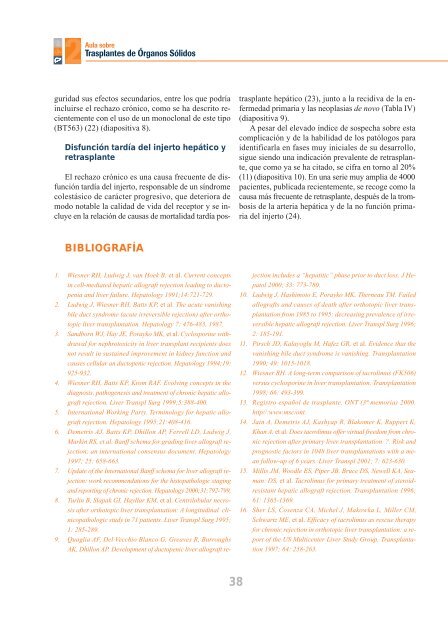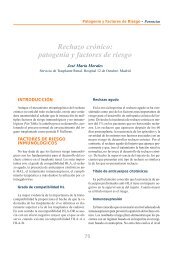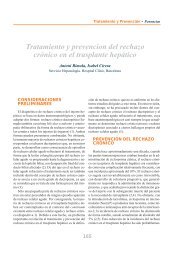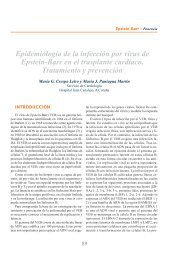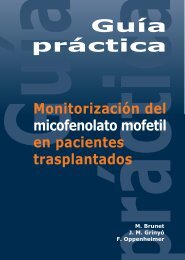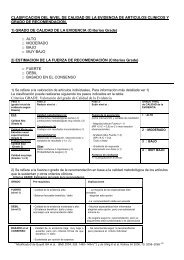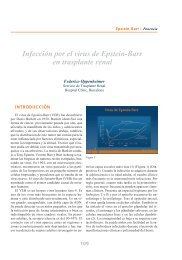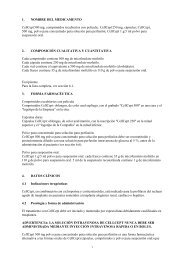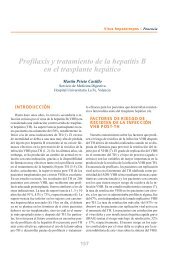Aula sobre Trasplantes de Órganos Sólidos - Roche Trasplantes
Aula sobre Trasplantes de Órganos Sólidos - Roche Trasplantes
Aula sobre Trasplantes de Órganos Sólidos - Roche Trasplantes
Create successful ePaper yourself
Turn your PDF publications into a flip-book with our unique Google optimized e-Paper software.
guridad sus efectos secundarios, entre los que podríaincluirse el rechazo crónico, como se ha <strong>de</strong>scrito recientementecon el uso <strong>de</strong> un monoclonal <strong>de</strong> este tipo(BT563) (22) (diapositiva 8).Disfunción tardía <strong>de</strong>l injerto hepático yretrasplanteEl rechazo crónico es una causa frecuente <strong>de</strong> disfuncióntardía <strong>de</strong>l injerto, responsable <strong>de</strong> un síndromecolestásico <strong>de</strong> carácter progresivo, que <strong>de</strong>teriora <strong>de</strong>modo notable la calidad <strong>de</strong> vida <strong>de</strong>l receptor y se incluyeen la relación <strong>de</strong> causas <strong>de</strong> mortalidad tardía postrasplantehepático (23), junto a la recidiva <strong>de</strong> la enfermedadprimaria y las neoplasias <strong>de</strong> novo (Tabla IV)(diapositiva 9).A pesar <strong>de</strong>l elevado índice <strong>de</strong> sospecha <strong>sobre</strong> estacomplicación y <strong>de</strong> la habilidad <strong>de</strong> los patólogos parai<strong>de</strong>ntificarla en fases muy iniciales <strong>de</strong> su <strong>de</strong>sarrollo,sigue siendo una indicación prevalente <strong>de</strong> retrasplante,que como ya se ha citado, se cifra en torno al 20%(11) (diapositiva 10). En una serie muy amplia <strong>de</strong> 4000pacientes, publicada recientemente, se recoge como lacausa más frecuente <strong>de</strong> retrasplante, <strong>de</strong>spués <strong>de</strong> la trombosis<strong>de</strong> la arteria hepática y <strong>de</strong> la no función primaria<strong>de</strong>l injerto (24).BIBLIOGRAFÍA1. Wiesner RH, Ludwig J, van Hoek B, et al. Current conceptsin cell-mediated hepatic allograft rejection leading to ductopeniaand liver failure. Hepatology 1991;14:721-729.2. Ludwig J, Wiesner RH, Batts KP, et al. The acute vanishingbile duct syndrome (acute irreversible rejection) after orthotopicliver transplantation. Hepatology 7: 476-483, 1987.3. Sandborn WJ, Hay JE, Porayko MK, et al. Cyclosporine withdrawalfor nephrotoxicity in liver transplant recipients doesnot result in sustained improvement in kidney function andcauses cellular an ductopenic rejection. Hepatology 1994;19:925-932.4. Wiesner RH, Batts KP, Krom RAF. Evolving concepts in thediagnosis, pathogenesis and treatment of chronic hepatic allograftrejection. Liver Transpl Surg 1999;5:388-400.5. International Working Party. Terminology for hepatic allograftrejection. Hepatology 1995;21:408-416.6. Demetris AJ, Batts KP, Dhillon AP, Ferrell LD, Ludwig J,Markin RS, et al. Banff schema for grading liver allograft rejection:an international consensus document. Hepatology1997; 25: 658-663.7. Update of the International Banff schema for liver allograft rejection:work recommendations for the histopathologic stagingand reporting of chronic rejection. Hepatology 2000;31:792-799.8. Turlin B, Slapak GI, Hayllar KM, et al. Centrilobular necrosisafter orthotopic liver transplantation: A longitudinal clinicopathologicstudy in 71 patients. Liver Transpl Surg 1995;1: 285-289.9. Quaglia AF, Del Vecchio Blanco G, Greaves R, BurroughsAK, Dhillon AP. Development of ductopenic liver allograft rejectioninclu<strong>de</strong>s a “hepatitic” phase prior to duct loss. J Hepatol2000; 33: 773-780.10. Ludwig J, Hashimoto E, Porayko MK, Therneau TM. Failedallografts and causes of <strong>de</strong>ath after orthotopic liver transplantationfrom 1985 to 1995: <strong>de</strong>creasing prevalence of irreversiblehepatic allograft rejection. Liver Transpl Surg 1996;2: 185-191.11. Pirsch JD, Kalayoglu M, Hafez GR, et al. Evi<strong>de</strong>nce that thevanishing bile duct syndrome is vanishing. Transplantation1990; 49: 1015-1018.12. Wiesner RH. A long-term comparison of tacrolimus (FK506)versus cyclosporine in liver transplantation. Transplantation1998; 66: 493-399.13. Registro español <strong>de</strong> trasplante. ONT (3ª memoria) 2000.http//:www.msc/ont.14. Jain A, Demetris AJ, Kashyap R, Blakomer K, Ruppert K,Khan A, et al. Does tacrolimus offer virtual freedom from chronicrejection after primary liver transplantation ?. Risk andprognostic factors in 1048 liver transplantations with a meanfollow-up of 6 years. Liver Transpl 2001; 7: 623-630.15. Millis JM, Woodle ES, Piper JB, Bruce DS, Newell KA, SeamanDS, et al. Tacrolimus for primary treatment of steroidresistanthepatic allograft rejection. Transplantation 1996;61: 1365-1369.16. Sher LS, Cosenza CA, Michel J, Makowka L, Miller CM,Schwartz ME, et al. Efficacy of tacrolimus as rescue therapyfor chronic rejection in orthotopic liver transplantation: a reportof the US Multicenter Liver Study Group. Transplantation1997; 64: 258-263.38


